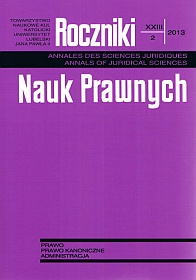Declaration of Death and the Possibility To Conclude New Marriage. Selected Areas of Civil and Canon Law
Abstract
The cessation of marriage is an untypical but rather interesting institution of law. The presented analysis lays emphasis on one spouse being declared dead, the fact which produces certain legal consequences for the life of the other spouse. The fundamental principles that underlie the Family and Guardianship Code provide that marriage is a permanent and virtually lifelong union of two persons. Consequently, the death of either of the spouses is a natural end to their union. The Code does not elaborate on this, presuming this consequence to be so obvious that it became necessary to regulate the cessation of marriage if either spouse is declared dead. A different treatment of cessation of marriage due to a spouse’s death can be found in the provisions of Registry Office Records Act. It provides that a certified copy of a death certificate, among other documents, is a proof that marriage has ceased to exist. Another proof would be a judicial decision on the declaration of death pursuant to the Code of Civil Procedure. A reliable determination of the death of one spouse is of great significance to the life situation of the living spouse, namely his or her civil status and a possibility to re-enter into marriage. Apparently, the Polish legislator favours this new union since it can be annulled only when the nuptrients acted in bad faith knowing that the spouse who was presumed dead was in fact alive. It must be noted that a majority of marriages concluded in Poland are subject to Polish Family Law and Canon Law. Although socially recognised, this fact is not formally and legally uniform since it is subject to two distinct legal orders. They regulate matters concerning disappearance (death) of a spouse differently. Under Canon Law, a diocesan bishop issues a declaration of presumed death, which allows the living spouse to re-enter into sacramental matrimony. This document constitutes only a presumption that a missing spouse is dead. If otherwise were true, the new union is to be broken and the previous spouses reunited.
References
Adamowicz L., Wzory pism i formularzy używanych w kancelarii parafialnej, Lublin 2001.
Bartosiewicz A., Postępowanie o uznanie za zmarłego i stwierdzenie zgonu, Warszawa 2007.
Bączkowicz F., Prawo kanoniczne. Podręcznik dla duchowieństwa, t. II, Opole 1958.
Ignatowicz J., Nazar M., Prawo rodzinne, Warszawa 2010.
Pawluk T., Prawo kanoniczne według Kodeksu Jana Pawła II, t. IV, Olsztyn 1990.
Piasecki K., Prawo małżeńskie, Warszawa 2011.
Pospishil V.J., Eastern Catholic Marriage Law. According to the Code of Canons of the Eastern Churches, New York 1991.
Pospishil V.J., Eastern Catholic Church Law. According to the Code of Canons of the Eastern Churches, New York 1993.
Smyczyński T., Prawo rodzinne i opiekuńcze, Warszawa 2009.
Sztafrowski E., Podręcznik prawa kanonicznego, t. IV, Warszawa 1986.
Copyright (c) 2013 Roczniki Nauk Prawnych

This work is licensed under a Creative Commons Attribution-NonCommercial-NoDerivatives 4.0 International License.


